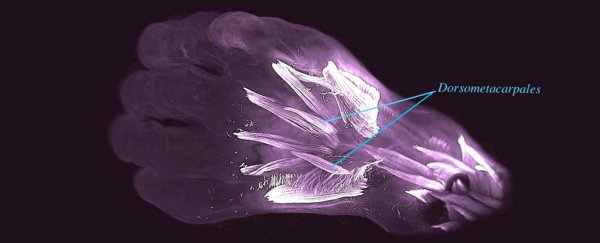Back when you were just a fingernail-sized blob in your mother's uterus, your tiny baby flippers had far more in common with the paws of ancient reptiles than you might be comfortable with.
Special immunostaining techniques carried out by scientists from Washington's Howard University and Sorbonne University in Paris have revealed new human atavisms – remnants of anatomy that evolution never completely ditched – which help to explain how our bodies evolved.
"It used to be that we had more understanding of the early development of fishes, frogs, chicken and mice than in our own species, but these new techniques allow us to see human development in much greater detail," says Howard University evolutionary biologist, Rui Diogo.
Limb muscles thought to have been abandoned by our mammalian ancestors 250 million years ago never completely went away. In most of us, the muscles dissolve long before we're born, but these 'reptilian' remnants can still be found in some adults.
In the new study, by scanning the tissues of more than a dozen embryos and young foetuses in high-res 3D over a number of weeks, the team found tiny muscles in the hands and feet of a 7-week-old that were no longer visible by week 13.
While it's not the first time researchers have looked closely at the coming-and-going of tissues in tiny humans, most research on limb muscles has focussed on earlier weeks, missing crucial changes.
As the researchers watched, around a third of the muscles in the embryo's hands and feet simply withered away over the days, or fused with their neighbours.
Crucially, the fact some of them exist at all in our lifetime is a little surprising. Muscles called dorsometacarpales were thought to have been thrown out of the mammalian instruction manual back when evolution was still coming up with our prototypes around 250 million years ago.
The study's record of limb development also challenges the assumption that lower limbs are more or less copies of our upper limbs.
While in adults the two parts have similar-looking structures that make it seem like a cut-and-paste job, the order of development of key muscle groups suggests the limbs came to resemble each another's forms over time.
Evolution is a funny thing. While we often use language that imagines it has some grand plan, biology is more often than not a process of trial and error, where random changes modify structures to potentially suit new functions.
Evolutionary biologists have the task of teasing apart the process of this modification, often by looking for anatomical structures to compare between modern organisms.
Finding the faint traces of ancient muscles early in our development adds crucial details to the story of our evolution.
As Diogo explained to BBC's Michelle Roberts, the way organisms adapt isn't a simple process of throwing out an old plan in favour of a new one.
"Probably, we cannot just say in evolution, 'Look, I will delete from scratch, from day zero, the muscle going to digits two, three, four, five, and I will just keep the one going to the thumb'."
To add to the complexity, the researchers note adults with certain chromosomal disorders don't lose these muscles, either as a seemingly healthy variation or as a result of congenital malformation.
"This reinforces the idea that both muscle variations and pathologies can be related to delayed or arrested embryonic development, in this case perhaps a delay or decrease of muscle apoptosis, and helps to explain why these muscles are occasionally found in adult people," says Diogo.
"It provides a fascinating, powerful example of evolution at play."
Applying similar staining and imaging technology to other stages in human development could yet reveal other structures long thought to have faded from our bodies.
This research was published in Development.
